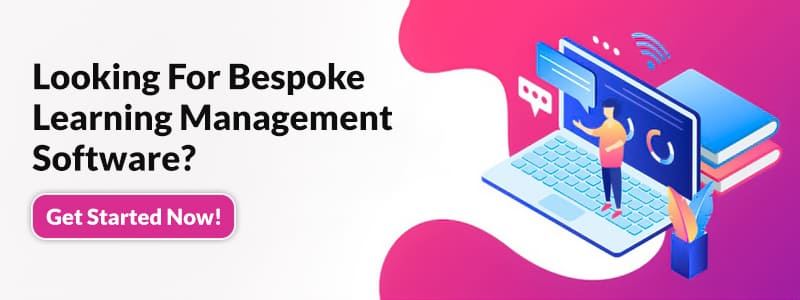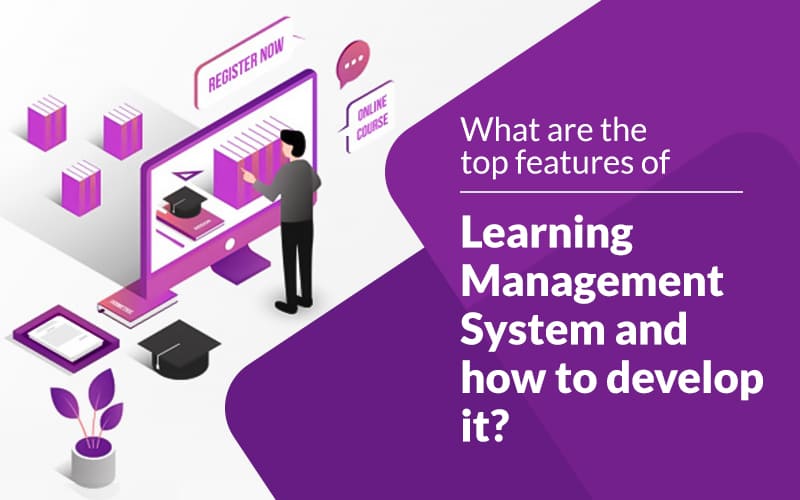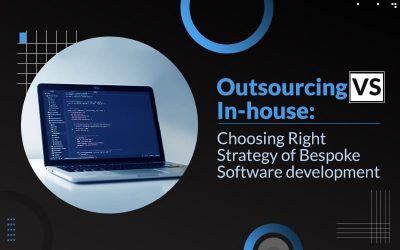What Are The Top Features Of A Learning Management System, And How To Develop It?
Technology is constantly evolving and influencing every aspect of companies. Organizations today all over the world have understood the value of preparing/teaching their employees in order to increase productivity. Many organizations of all sizes and industries are investing in a Learning Management System (LMS) to help them handle and promote eLearning.
A learning management system (LMS) is a software application that helps with administrative duties, research, reports, information gathering, and the delivery of learning. While it was designed to enhance e-learning, top businesses are now using a custom learning management system due to its various advantages.
If you are reading this, you are most likely looking for the first or maybe next learning management system, or either if you’re unsure how to develop a learning management system, we can help.
For decades, as a leader in web application development, we’ve been assisting plenty of potential clients who have come to us with demands for customized learning management systems for their businesses.
In this blog post, we’ll discuss what an LMS is, how it’s used, and the different forms of LMSs. We also go through the main features and steps to building an effective learning management system.
So, let’s get started!
What is a Learning Management System?
A learning management system, also known as an LMS, is a web-based application that streamlines the learning experience for staff, students, as well as other users. You can collect all of your learning resources in one location and make them accessible to all learners with only one click using a learning management system. You may also divide learners into different classes based on their functions or job titles. Learners can download all course material from any computer using these software programs, which handle all types of media like video, classes, and documentation.
Digital learning, integration with several other cloud systems, data collection, and assistance for gamification, socialization, and learning on the go are all features of today’s modern learning management system systems. Artificial intelligence is also used in LMS systems to recognize each learner’s actions better to create customized learning experiences.
How Learning management system can be used?
A corporate learning management system (LMS) is mainly used for training and development. In your company, you can provide training to a variety of users, groups and business styles.
Learning management systems is used worldwide across various industries like:
- Businesses of all sizes, ranging from small, family-owned businesses to large, multinational corporations
- Educational associations focused on learning like Udemy, EDX, CodeChef, Coursera, and many others.
- Traditional educational institutions
In the world of online learning, an LMS is the next game-changer. To prove this, check out the following statistics:
- As per the MarketsandMarkets study, the global market for this sector will grow to nearly $15.72 billion by 2021. Its worldwide market size is expected to hit nearly $22.4 billion by 2023
- Large businesses, which benefit from having a readily accessible, structured learning environment, account for almost 30% of LMS users.
Still not persuaded by either of these numbers? Here are some reasons and benefits of LMS, which can shock you.
What are the Reasons and Benefits of Developing a Learning Management System?
Here are the top reasons and benefits of learning management system development.
- You can arrange all of your learning material in one place with an LMS
- Message continuity is allowed by LMSs
- Easy to use
- Encourages easy communication
- Reduce employee, client, and partner training and onboarding time.
- Keep track of a learner’s performance.
- Enables to analyze the effect of learning on organizational success.
Since we discussed the learning management system, use cases, and its reasons and benefits, now let’s discuss how to develop your custom learning management system.
 But before that, let’s quickly discuss!
But before that, let’s quickly discuss!
What features to include in the Learning Management System?
Learning management systems on the market have a wide range of features to choose from. Here are among the most must-have features to look for in your learning management system. So take a look!
- Manage Users – Executives may allow or disable user access to specific functionality to protect confidential data or prevent novice teammates from inadvertently damaging the app. Administrators, curriculum admins, revenue partners, and analysts are only a few users who need to be accommodated by an LMS.
- Device Compatibility – For decades, mobile phones have outsold desktop devices, and you’ll need an LMS system that works with the new Android and Apple phones and tablets. Providing training with the ability to explore from anywhere requires creating a sensitive, seamless user interface.
- Dashboard – Instructors may use dashboards to coordinate all applicable data and tidy for monitoring and recording comprehensive statistics. Information such as overall average score, learner attendance task submissions stats, and learner response time could be included in such interfaces, personalized to meet user needs.
- Gamification – Enable learners to receive points, badges, prizes, and other rewards for completing all learning activities.
- Integrations – Keep the company’s data in line with an LMS that supports third-party implementations and plugins with other systems like Salesforce CRM, video conferencing software, and so forth.
- Attendance Management – Instructors can monitor learner attendance for training sessions using certain LMS services, regardless of whether the learner was late or absent. Learners will then review their attendance records online to see how they rank in the class.
- Certifications – Learning management systems rely heavily on certificates. While most LMSs have this feature, many LMS users might also want to incorporate their application with other applications like Accredible to produce certificates and achievement medals.
- Reminders – At the very least, you would like to send your learners a weekly email notification to let them know which courses they still need to finish on your platform. This improves learner participation and, as a result, course retention!
- Quizzes – Quizzes are not only for determining whether or not the learners are learning. They’re also a perfect way to mix it up and make learning more engaging in the class.
- Multilingual support – It’s essential for an LMS to embrace multiple languages, specifically in the context of global organizations.
- Content Management – Just as content is essential for the creation of an app or website, it is also crucial for the development of LMS. When you develop your own LMS, you ought to use the content management function to generate content that can be used to train staff.
- Branding – A white label training platform is essential for brand continuity, data protection, and user experience while teaching outside audiences.
 What are the Essential Steps to take before developing your Learning Management System?
What are the Essential Steps to take before developing your Learning Management System?
Now that you know what to check for in a learning management system follow the steps below to learn how to build one.
1. Create a plan
Developing an idea without first knowing about its market appeal can be highly detrimental to a company’s bottom line. So, which kind of data do you look at when we’re deciding whether or not to construct an LMS system? This move necessitates a study procedure that incorporates both statistical and market research.
Here’s how to make a project plan for your LMS. Begin by pondering the following fundamental questions:
- Why is it essential to build an LMS website?
- What issues does your company currently face, and how would this LMS address them?
- Who would build the LMS from the ground up?
- How much money are you willing to put into the implementation of a learning management system?
There are many more things to think about when creating a project plan, but these are the most key ones that will help you get started.
2. Decide Features and Functionality
We have already mentioned the top features that you need to include in your custom library management system.
In case if you want some other features and functionality for your library management system, you can contact us. Experts at Matellio would love to assist you.
3. Decide UI/UX
Designing the user interface is a difficult task, especially if you really do not have technical knowledge. As a start-up or company owner, you’ll almost certainly hire a development team, but it’s fine to imagine the system before hiring someone to build it for you. Make sure the user interface and user experience (UX) are both user-friendly and sensitive since it is the company’s first point of contact with the customer. If that isn’t enough to spark the customer’s interest, he or she is unlikely to return to the app anytime soon.
4. Choose the right development partner & Tech Stack
It’s not easy to choose an LMS website design and development partner. It’s even more difficult to find one that can meet the location-specific site requirements. The best aspect about recruiting a professional development partner is the variety of options you’ll have.
For developing a custom learning management system, you will need a top-notch tech stack. Below we’ve listed the tech stack we use to develop a learning management system for our various clients. So take a look!
- Frontend – JavaScript, Bootstrap, CSS3, Vue JS, Angular JS, React JS.
- Framework – CakePHP, ASP.NET, NodeJS, Laravel.
- Language – Python, PHP, Scala, JS.
- Database – MySQL, MongoDB, Amazon Relational Database Service, PostgreSQL.
At Matellio, we have a team of technical experts who can quickly identify the best software stack for your LMS needs. List your specifications, and our in-house experts will assist you in creating the learning management system from the ground up with the tech stack of your choice.
5. Test your LMS Software
We’ve arrived at the last stage of the process: testing and releasing the platform. Before we build and launch the learning management software application, we run it through a series of tests to ensure that all of the functionality and functionalities are working properly.
Immediately after the release of a product with glitches and technological flaws, the system will collapse. That’s why you’ll want to work with a company with a QA team that knows what they’re doing. Throughout the learning management system production phase, they would be responsible for ensuring the product’s consistency and authenticity.
As of now, we’ve discussed steps to develop a learning management system. Now, let’s move forward and discuss,
How much does it Cost to develop a Learning Management System?
The cost of developing a learning management system varies depending on whether you design it from the start or use a ready-made tool. Moving with a custom solution would make things more straightforward to get an app that functions the way you need. Request a quote from the best software development company like us to know the actual development cost of the learning management system as per your needs.
Conclusion
By now, we believe you have a clear understanding of the learning management system and what it can do for you and your business. Bear in mind, however, that the Learning Management System development process will continue after the release. You must continue to search for ways to enhance the framework, refine content, and add more opportunities and the ability to enhance the user interface.
If you’ve been looking for the best learning management software development solutions, Matellio will help!
Recommended Read : What Are The Top Benefits Of Bespoke Software Development?





